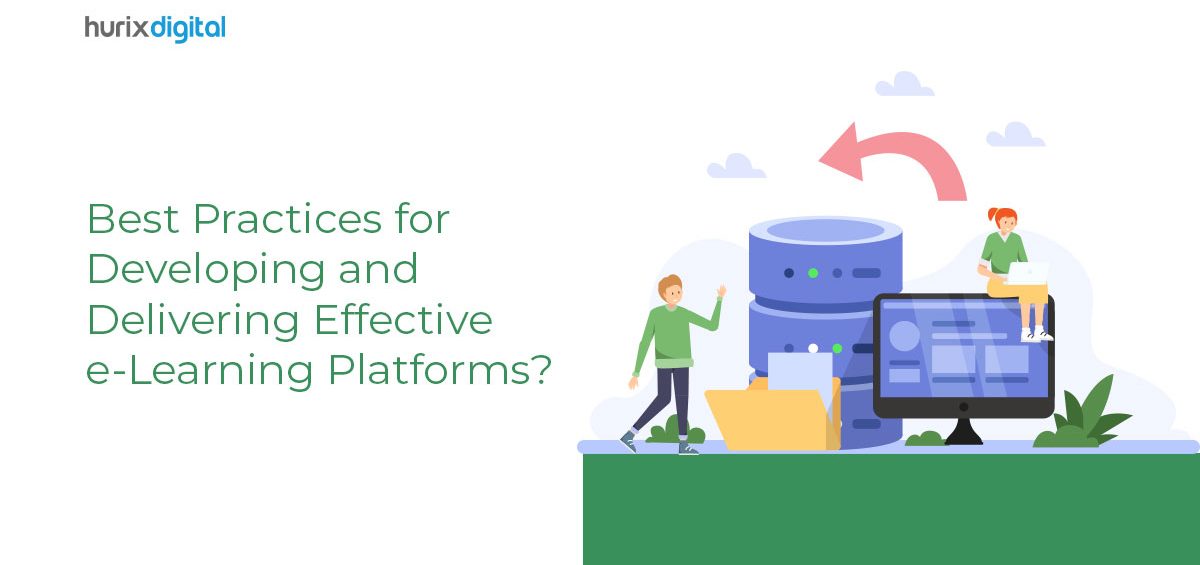The COVID-19 Pandemic broke the educational system from its traditional roots and thrust it into the digital era. With the rise of remote learning and digital transformation, e-learning has become a popular and effective way to deliver education and training content to learners.
As a result, custom e-learning platforms have become integral to the fields of education and training today.
To be effective, e-learning platforms require careful planning and execution. In this blog, we will explore the best practices for building custom e-learning solutions that will help you as educators engage your learners and deliver improved learning results.
Develop Top-Notch Custom E-Learning Platforms: 9 Best Practices
Learning by trial and error does teach a lot, but this method is not always feasible in all scenarios. These best practices can help you save a lot of time, investment, and effort in getting things right off the bat.
Understand Your Target Audience
To create custom e-learning solutions that best suit the needs of your learners, you must first understand your target audience. Factors such as their demographics, educational backgrounds, and learning styles can make your platform something they can get comfortable using immediately.
Conducting surveys and focus groups is also a great way to gather information about your learners and create personas to guide the development of your e-learning platform.
It also pays to pay close attention to the devices and technologies your target audience is using. It can help you improve the design and functionality of your e-learning platform to add further appeal for the intended users.
Set Clear Learning Objectives
Setting clear and measurable learning objectives is critical to the success of your e-learning platform.
These objectives should align with the overall goals of your custom e-learning solutions and provide learners with a clear understanding of what they can achieve by completing the course.
Additionally, ensure that your objectives are specific, measurable, attainable, relevant, and time-bound (SMART), as this can help you evaluate the effectiveness of your e-learning platform.
Ensure Support for Multimedia
Multimedia elements have proven more effective when understanding difficult concepts and knowledge retention. Incorporating multimedia support into your e-learning platform can help cater to different learning styles and enhance the learning experience.
That being said, it’s vital to ensure that the multimedia elements are relevant to the learning objectives and support the content of the course.
Experienced Custom e-learning development services can help you select the appropriate multimedia elements that will be most effective based on the end goals of your e-learning platform.
Enforce a Consistent Structure Throughout Your Platform
Maintaining a consistent structure throughout your e-learning platform can help learners navigate the platform and its courses more quickly.
Factors such as a clear and concise menu, a consistent layout for each lesson, and a logical flow for the course can make your platform look more professional and help you stand out from your competition.
Additionally, providing progress indicators and completion tracking across all courses can also help learners understand how far they have come and how much learning they still need to accomplish.
Design for Accessibility
Designing your e-learning platform for accessibility is crucial to ensure all learners can access and benefit from using your platform. This can include providing alternative formats, such as audio or text transcripts, and ensuring the platform is navigable using assistive technologies.
Additionally, following web content accessibility guidelines (WCAG) can help ensure your e-learning platform is accessible to learners with disabilities. Today’s users put a lot of emphasis on how socially responsible companies are.
Inclusivity can go a long way in building a good name for your platform and organization as a whole.
Incorporate Learning via Gamification
Learning via Gamification is here to stay because of the multitude of benefits it offers. In addition, Gamification can be a powerful tool for custom e-learning solutions, as it can help motivate learners and enhance engagement.
However, it’s crucial to ensure that the gamification elements you incorporate into your e-learning platform align with the learning objectives of your intended customer base.
Incorporate Support for Personalized Learning
Like Gamification, personalized learning experiences can help learners feel more engaged and motivated. Education is no longer a one size fits all solution, and personalized learning has proven effective in the context of improved learning outcomes for all.
Ensure your platform includes personalized learning elements such as tailoring the content of the course to the learner’s interests, providing customized assessments and quizzes, and enabling learners to track their progress and receive personalized feedback.
Consulting experienced Custom e-learning development services can help you navigate the complexities of implementing personalization for your learners and develop an e-learning platform that meets their individual needs.
Ensure the Security and Privacy of All Sensitive Information
Ensuring the security and privacy of your learners’ data is critical to maintaining their trust and protecting sensitive information. This can include implementing appropriate security measures such as SSL certificates, firewalls, and data encryption.
Additionally, ensuring compliance with data protection laws such as GDPR and CCPA can help ensure that your e-learning platform meets legal requirements and protects the privacy of your learners.
Test, Refine, and Repeat
Testing and refining your e-learning platform continuously is crucial to ensuring that it always meets the ever-evolving needs of your learners and achieves its intended objectives.
Usability testing, A/B testing, and gathering feedback from learners and instructors are exercises that must be performed regularly to ensure your platform is always one step ahead of your competition.
Enlisting the expertise of Custom e-learning development services can help you conduct these tests and provide recommendations for improvement to help ensure your service remains relevant and effective in a rapidly evolving technological landscape.
Summing It Up
Building high-quality e-learning platforms requires a ton of careful planning and execution. Following the above-mentioned best practices can create effective e-learning experiences that engage learners and deliver results.
These best practices have been implemented with one specific goal – to improve learning outcomes, which will contribute to your e-learning platform’s success.
Are you looking to develop a high-quality e-learning platform for your higher education institution? HURIX Digital’s Higher Education services can help. Our expertise can help you to design and develop a personalized e-learning platform that meets the unique needs of your learners and achieves your learning objectives.
Contact us today to learn more about how our higher education services can transform your e-learning platform.








